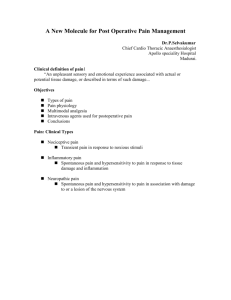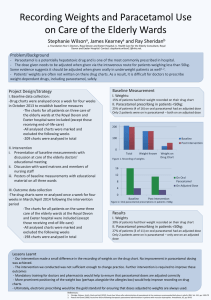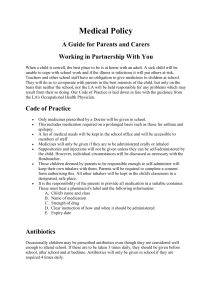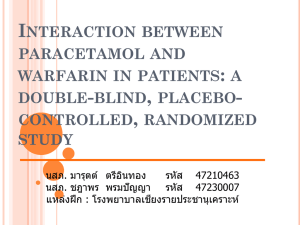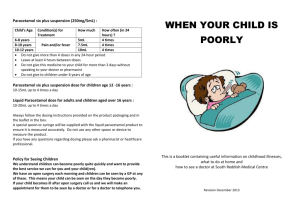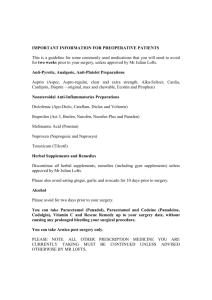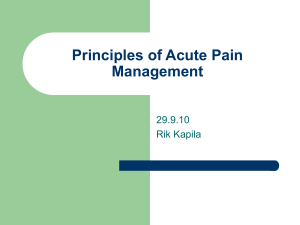development and validation of uv spectrophotometric method for
advertisement
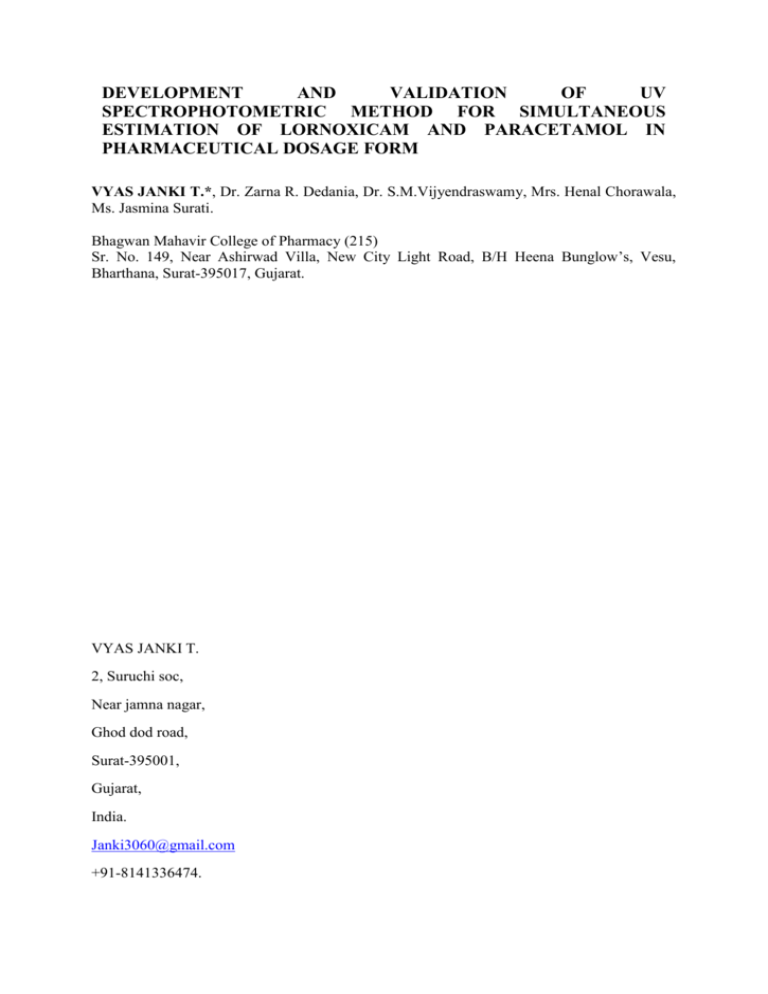
DEVELOPMENT AND VALIDATION OF UV SPECTROPHOTOMETRIC METHOD FOR SIMULTANEOUS ESTIMATION OF LORNOXICAM AND PARACETAMOL IN PHARMACEUTICAL DOSAGE FORM VYAS JANKI T.*, Dr. Zarna R. Dedania, Dr. S.M.Vijyendraswamy, Mrs. Henal Chorawala, Ms. Jasmina Surati. Bhagwan Mahavir College of Pharmacy (215) Sr. No. 149, Near Ashirwad Villa, New City Light Road, B/H Heena Bunglow’s, Vesu, Bharthana, Surat-395017, Gujarat. VYAS JANKI T. 2, Suruchi soc, Near jamna nagar, Ghod dod road, Surat-395001, Gujarat, India. Janki3060@gmail.com +91-8141336474. ABSTRACT A novel analytical UV spectrophotometric method has been developed in presented research work for simultaneous estimation of Lornoxicam and Paracetamol in pharmaceutical dosage form. In the proposed First Order Derivative method, linearity range was observed in the concentration range of 1-6 µg/ml for Lornoxicam and 12-32 µg/ml for Paracetamol with r2 values 0.9987 and 0.999 respectively. The wavelengths selected were 346 nm and 288 nm, corresponding to the Zero crossing point (ZCP) of Paracetamol and Lornoxicam in 0.1 N Sodium Hydroxide respectively. The limit of detection for Lornoxicam and Paracetamol were found to be 0.090μg/ml and 1.809μg/ml respectively. Limit of quantification were found to be 0.274μg/ml and 5.483μg/ml for Lornoxicam and Paracetamol respectively. Validation of the proposed method was carried out for its accuracy and precision according to ICH guidelines. The accuracy of the method was checked by recovery experiment performed at three different levels of 80%, 100% and 120 %. The percentage recoveries of Lornoxicam and Paracetamol were found to be in the range of 99.15-101.16% and 99.44-101.09% respectively. The low values of % relative standard deviation (RSD) are indicative of the accuracy and reproducibility of the method. The precision of the method was studied as an intra-day, inter-day variations and repeatability. The % RSD value less than 2 indicate that the method is precise. The method was found to be rapid, simple, accurate and precise. Key words: Lornoxicam, Paracetamol, First order derivative UV spectrophotometric method, validation. INTRODUCTION: Lornoxicam belongs to the chemical class oxicams, which includes piroxicam, tenoxicam and meloxicam. It has non steriodial anti‐inflammatory activity. It is used to treat inflammatory diseases of the joints, osteoarthritis, pain after surgery, and sciatica. It works by blocking the action of cyclooxygenase, an enzyme involved in the production of chemicals, including some prostaglandins in the body[1,2] . Chemically, Lornoxicam (LOR) is (3E)‐6‐ chloro‐3‐[hydroxyl (pyridine‐2‐ylamino)methylene]‐2‐methyl‐2,3‐ dihydro‐4H‐thieno[2,3‐e][1,2]thiazin‐4‐one‐ 1,1‐dioxide.[3]. Lornoxicam is not official in any Pharmacopoeia, but listed in the Merck Index [4]. Few analytical methods for determination of lornoxicam using UV method [5,6] , Bioanalytical method[7], spectro-fluorimetry method [8], HPLC[9,10] RP-HPTLC[11,12], stability indicating HPLC method[13] have been reported. [A] [B] Chemical Structure of [A]Lornoxicam, [B] Paracetamol. Paracetamol is chemically 4-hydroxy acetanilide. It is a centrally and peripherally acting nonopioid analgesic and antipyretic.[14,15] Paracetamol is official in I.P[16], B.P[17] and USP[18]. Literature survey reveals that there are UV method[19,20] and UV and HPTLC methods of Paracetamol with other drugs[21,22] have been reported for the estimation of Paracetamol in Pharmaceutical formulations. Extensive Literature survey reveals that there are some UV method, i.e. simultaneous equation method and absorbace Q ratio method[23,24], RP- HPLC methods[25] have been reported for simultaneous estimation of Lornoxicam and Paracetamol in combined dosage form. However, First order derivative method has not yet reported for simultaneous estimation of both drugs in combination. This paper presents simple, rapid, reproducible and economical method for the simultaneous analysis estimation of both the drugs from pharmaceutical dosage form. The proposed method was optimized and validated in accordance with International Conference on Harmonization (ICH) guidelines15. MATERIALS AND METHODS: Instrumentation: UV ‐ Visible spectrophotometer Shimadzu-1800 Chemicals and reagents: Lornoxicam and Paracetamol working standards were procured from Stallion Laboratories Pvt. Ltd., Ahmedabad and Dolphin Pharmaceutical Ltd, Surat. The tested pharmaceutical marketed formulation (Lornoxi-P - Lornoxicam 8mg, paracetamol 325mg) were procured from commercial pharmacy. Reagents were of suitable analytical grade. Marketed tablet preparation used wasTrade Name Company Dose Name Batch Number Manufactur ed Date Expiry Date Lornoxi-P 3114306 May2014 Apr2016 Hetero Labs LornoxicamLimited 8mg, Paracetamol325mg. Selection of wavelength for First order derivative method: In First order derivative method overlain spectra showed that Zero crossing point for Paracetamol was found at 346nm. So, Lornoxicam was measured at 346nm. Zero crossing point (ZCP) for Lornoxicam was found at 288 nm. So, Paracetamol measured at 288 nm. Preparation of standard solution: Accurately weighed 100mg quantity of Lornoxicam and Paracetamol were transferred into different100 ml volumetric flasks, dissolved and diluted up to mark with 0.1N NaOH to get 1000μg/ml. From this solution 100μg/ml of Lornoxicam and Paracetamol solutions were prepared by diluting 10 ml of 1000μg/ml solutions to 100 ml with 0.1N NaOH. Preparation of working standard soutions: The standard solutions were further diluted to get working standard solutions of analytes in the concentration range of 1-6 μg/ml and 12-32 μg/ml for Lornoxicam and Paracetamol respectively. Analysis of Tablet Formulation: Twenty tablets were weighed and crushed to fine power. The amount of powder equivalent to 325mg of Paracetamol (8 mg of Lornoxicam) was weighed and transferred to 100ml volumetric flask. The drug content was shaken with 25ml of 0.1N NaOH and was kept in ultra sonicator for 15 min. Finally, the volume was made up to the mark with 0.1N NaOH. The solution was filtered through whatman filter paper No.41. The filtrate was further diluted to obtain 0.8 μg/ml and 32.5 μg/ml concentrations of Lornoxicam and paracetamol respectively. The spectras were scanned in the range of 400-200 nm. Amplitudes were measured from first order derivative spectra at 346 nm and 288 nm, selected ZCPs of Paracetamol and Lornoxicam respectively. Validation Parameters: 1. Linearity& Range: Linearity was found in the range of 1-6µg/ml for Lornoxicam and 12-36µg/ml for Paracetamol. Co-relation Co-efficient was found to be 0.9989 and 0.999 respectively. 2. Precision: The precision expressed as standard deviation or relative standard deviation. Intraday precision: Lornoxicam and Paracetamol were taken in a ratio was analyzed at three levels of concentration for three times in a day. Absorbances of the solutions were measured. The % RSD for Lornoxicam and Paracetamol were found to be less than % for the method. Interday precision: Lornoxicam and Paracetamol were taken in a ratio was analyzed at three levels of concentration for three consecutive days. Absorbances of the solutions were measured. The % RSD for Lornoxicam and Paracetamol were found to be less than 2% for the method. 3. Accuracy: The accuracy of the method was established using recovery technique i.e external standard addition method. The known amount of standard was added at three different levels to pre analyzed sample. Each determination was performed in triplicate. The result of recovery study is presented in Table. 4. Sensitivity: The sensitivity of measurements of FH by the use of the proposed method was estimated in terms of the limit of quantification (LOQ) and limit of detection (LOD). Formula: LOD= 3.3×M/S LOQ= 10×M/S Where, M is the standard deviation of y-intercepts of regression lines and S is the slope of the calibration curve. 5.Ruggedness: Ruggedness of the method was determined by analysis of aliquots from homogeneous slot by two analyst using same operational and environmental conditions. RESULT AND DISCUSSION: In this First order derivative method overlain spectra showed that Zero crossing point for Paracetamol at 346nm. So, Lornoxicam was measured at 346nm. Zero crossing point (ZCP) for Lornoxicam was found at 288 nm. So, Paracetamol measured at 288 nm. Both the drugs Lornoxicam and Paracetamol obeyed linearity range 1-6µg/ml and 12-32µg/ml respectively and correlation coefficient (r2) were found to be 0.9989and 0.9990 in both cases. The percentage purity of drugs in combined dosage form was found to be 100.12% for Lornoxicam and 99.79% for Paracetamol. The accuracy of the method was determined by performing recovery study by standard addition method. The % recoveries were found within 99.15%-101.09% for Lornoxicam and Paracetamol. The experiment was repeated three times in a day for intra-day and on three different days for inter-day precision. The method was found to be precise as % RSD for intra-day and inter-day precision were < 2. The limit of detection for Lornoxicam and Paracetamol were found to be 0.090μg/ml and 1.809μg/ml respectively. Limit of quantification were found to be 0.274μg/ml and 5.483μg/ml for Lornoxicam and Paracetamol respectively. Figure 1: First order derivative overlain spectra of Lornoxicam (1-6 µg/ml)and Paracetamol (12-36 µg/ml), and their ZCPs at 288nm and 346 nm respectively. Amplitudes of Lornoxicam at ZCP of pcm346nm 0.01 0.009 0.008 0.007 0.006 0.005 0.004 0.003 0.002 0.001 0 y = 0.0011x + 0.0024 R² = 0.9989 amplitude at 346nm Linear (amplitude at 346nm) 0 2 4 6 8 conc.(µg/ml) Figure 2: calibration curve for Lornoxicam (1-6 µg/ml), amplitudes taken at ZCP of paracetamol(346nm) Amplitude of paracetamol at ZCP of lornoxicam(288nm) 0.0000 0 10 20 30 40 conc.(µg/ml) -0.0050 Amplitude at 288 -0.0100 -0.0150 Linear (Amplitude at 288) -0.0200 -0.0250 -0.0300 y = -0.001x + 0.0035 R² = 0.9990 Figure 3: calibration curve for Paracetamol (12-36µg/ml), amplitudes taken at ZCP of Lornoxicam (288nm). Table 1: Accuracy studies: % Recovery of Lornoxicam and Paracetamol using First order Derivative Method Assay Tablet content Standard Total drugs % Recovery of Level taken eq. to (mg) added (mg) recovered (mg) standard added (n=3) Lor Pcm Lor Pcm Lor Pcm Lor Pcm 8 325 0 0 7.99 325.06 99.87 100.01 Blank 8 325 6.4 260 14.35 584.2 99.15 99.66 80% 8 325 8 325 16.01 648.19 100.16 99.44 100% 8 325 9.6 390 17.06 715.36 100.06 100.09 120% Table 2: Precision study: Intra-Day and Inter-Day Precision Drug Concentration [µg/ml] Intra-day amount found [µg/ml n=3] % R.S.D. Inter-day amount found [µg/ml n=3] % R.S.D. Lor 2 3 99.50±0.89 99.26±0.92 0.901 0.933 99.38±0.60 99.43±1.07 0.604 1.079 4 99.56±1.02 0.1.02 99.58±1.01 1.051 16 20 99.78±0.29 99.78±0.35 0.0.295 0.351 99.91±0.30 99.84±0.56 0.307 0.566 24 99.97±0.15 0.157 99.94±0.17 0.170 Pcm Table 3: LOD and LOQ: First order derivative method Lornoxicam Paracatamol LOD (µg/ml) 0.09042 1.8093 LOQ(µg/ml) 0.274 5.483 Table 4: Assay:Analysis of pharmaceutical tablet dosage form Tablet content taken eq. to (mg) Amount found (mg) Lornoxicam 8 Paracatamol 325 Assay (% Estimated) (n=3) Lornoxicam Paracatamol Lornoxicam Paracatamol 8.01 324.33 100.12% 99.79% CONCLUSION: The validated UV method proved to be simple, less expensive, fast, accurate, and precise and thus can be used for routine analysis of Lornoxicam and Paracetamol in synthetic mixture and tablet dosage forms. ACKNOWLEDGEMENTS: The authors are grateful to Stallion Laboratories Pvt. Ltd., Ahmedabad and Dolphin Pharmaceutical Ltd., Surat. for providing gift samples of Lornoxicam and Paracetamol. REFERENCES: 1. Rang HP, and Dale MM. Rang and Dale’s Pharmacology; 6th Edn; Elsevier ltd, 2007, pp 226-247. 2. Goyal RK, Balaraman R, and Burnade MD. Derasari and Gandhi elements of Pharmacology; 6th Edn; B.S.Shah Prakashan, Ahmadabad, 1997, pp 340-345. 3. http://www.drugbank.ca/drugs/db06725 (Accessed on 18th august 2014) 4. Merck Index ‐ an encyclopedia of chemicals and drugs and biologicals, 13th edition,5612. 5. Sahoo SK, Gir RK, Patil SV, Behera AR and Mohapatra R, “Development of Ultraviolet Spectrophotometric method for Analysis of Lornoxicam in solid dosage form.” Trop J. Pharm. Research. 2012, 11(2), 269-273. 6. Ramya NK, “Method Development and validation of lornoxicam in pharmaceutical dosage form by using UV-Visible Spectrophotometry.” Int J. Pharm. Bio. Arch. 2012, 3(4), 1012-1016. 7. Soni B, Khan F, Bhandari A and Sharma S, “Determination of Lornoxicam in Plasma by UV Spectroscopy.” Pharmacophore. 2011, 2(4), 239-243. 8. Suganthi A and Ravi TK, “Determination of Lornoxicam in Pharmaceutical formulation by Quenchofluorimetric Techchnique.” Int. J.A.PS.BMS, 2013, 2(1), 2125. 9. Young Hoon Kin, Hye Young Ji, Eun‐Seok Park, Soo‐Wan Chae, Hye Sik Lee: LC‐ Tandem Mass Spectrometric determination of Lornoxicam in human plasma,. Archieves of Pharmacal Research 2007;30(7):905‐910. 10. Kiran R. Patil, S. Devanand B. Shinde, Vipul P. Rane, Jaiprakash N, Sangshetti: Stability indicating LC method for analysis of Lornoxicam in dosage form. Chromatographia 2009; 69: 1001‐ 1005. 11. Kumar PK, Kumar DP, Kandhasamy MR and Siva KT, “RP-HPLC Development and validation for estimation of Lornoxicam in bulk and its solid dosaga form.” Int. J. Pharm. Chem. Sci. 2012, 2, 541-545. 12. Haque AM, Amrohi HS, Mohanty D and Diwan PV, “Analytical method development and validation for the estimation of Lornoxicam usin RP-HPLC in bulk drug and formulation.” Int. J. Pharm. 2012, 2(3), 640-644. 13. Bhatt PK, Hamrapurkar PD and Shigwan HS, “Development and validation of stability indicating RP-HPLC method for Lornoxicam in Bulk Drug.” Int. J. Res. Pharm. Biomed. Sci. 2013, 4(3), 959-966. 14. Anthony CM., David O. and Brian W., Clarke’s Analysis of Drugs and Poisons, 3rd Edn; Royal Pharmaceutical Society of Great Britain, 2004, 2, pp 1391-1393. 15. http://www.drugbank.ca/drugs/DB00316, (Accessed on 27th September, 2014) 16. Indian Pharmacopoeia, Govt. of India, Ministry of Health & Family Welfare, Indian Pharmacopoeial Commission, Ghaziabad, vol. 3, 2010, pp 1859-1862. 17. TheBritishPharmacopoeia,2007edition,Vol.II,1575. 18. USP‐NFAsianedition2007volume2,1269. 19. Behra S, Ghanty S, Fahad A and Banerjee SS, “UV –Visible spectrophotometric method development and validation of assay of Paracetamol tablet formulation.” J. Anal. Bioanal. Tech. 2012, 3(6), 1000151. 20. Buddha RS and Pradhanang R, “Spectrophotometric method for determination of Paracetamol.” J. Nepal Chem. Soc. 2009, 24, 39-44. 21. Deepali G and Pandurang D, “Simultaneous Estimation of Tramadol Hydrochloride and Paracetamol by UV Spectrophotometric Method from Tablet Formulation”, Int. J. PharmTech. Res., 2010, 2(2), 1119-1123. 22. Baheti KG, Shamim S, Shah N and Dehghan MH, “Validated simultaneous estimation of Paracetamol and Etoricoxib in bulk and tablet by HPTLC method, Inter. J. Res. PharmaCeut. Biomed. Sci., 2011, 2(2), 672-675. 23. Banerjee T, Banerjee B, Jain P, Shulka G and Banerjee A, “Spectrophotometric estimation of Lornoxicam and Paracetamol tablet dosage form using Hydrotropoic Solubilizing Agent.” Int. J. Chem. Tech. 2012, 4(1) 232-239. 24. Jain N, Jain K , “Spectrophotometric Quantitative Estimation of Lornoxicam and Paracetamol in Bulk Drugs and Dosage Form” Der Pharma Chemica, 2010, 2(6):165170. 25. Borisagar SL, Patel HU, Patel AN and Patel CN, “A Validated HPLC method for estimation of Lornoxicam and Paracetamol in their combined tablet dosage form.” Int. J. Pharm. Sci. Res. 2011, 2(7), 1683-1686.
